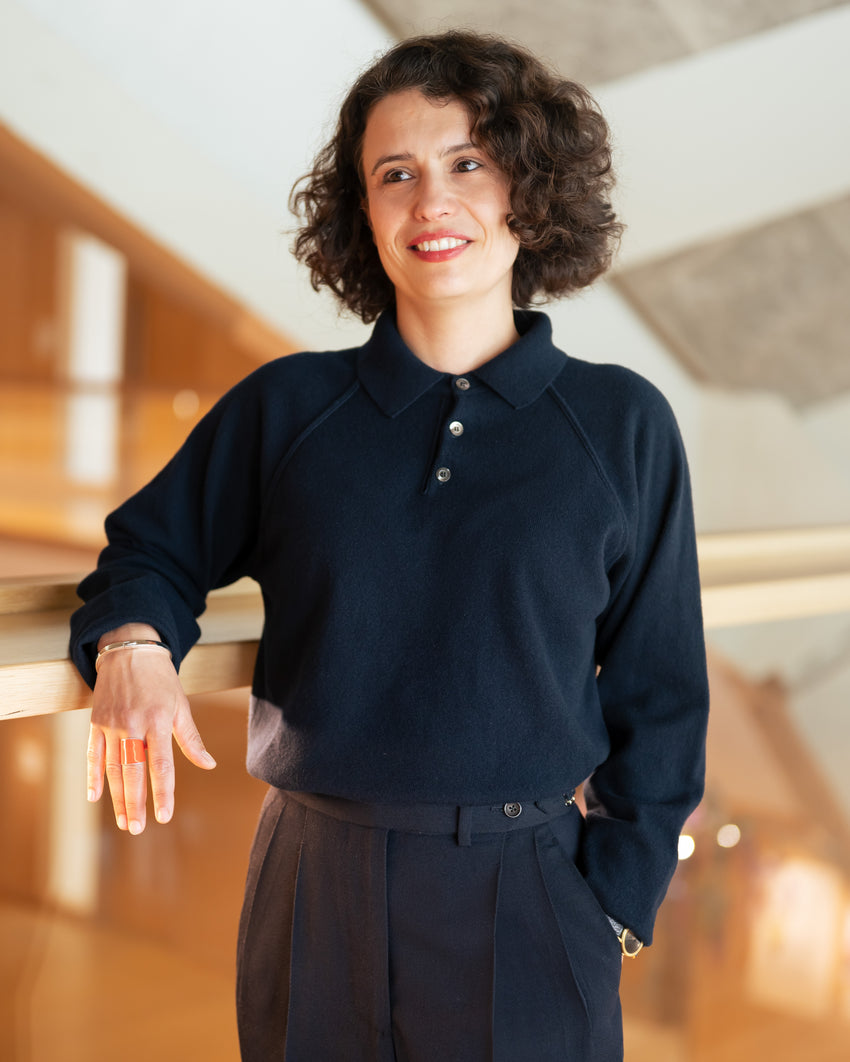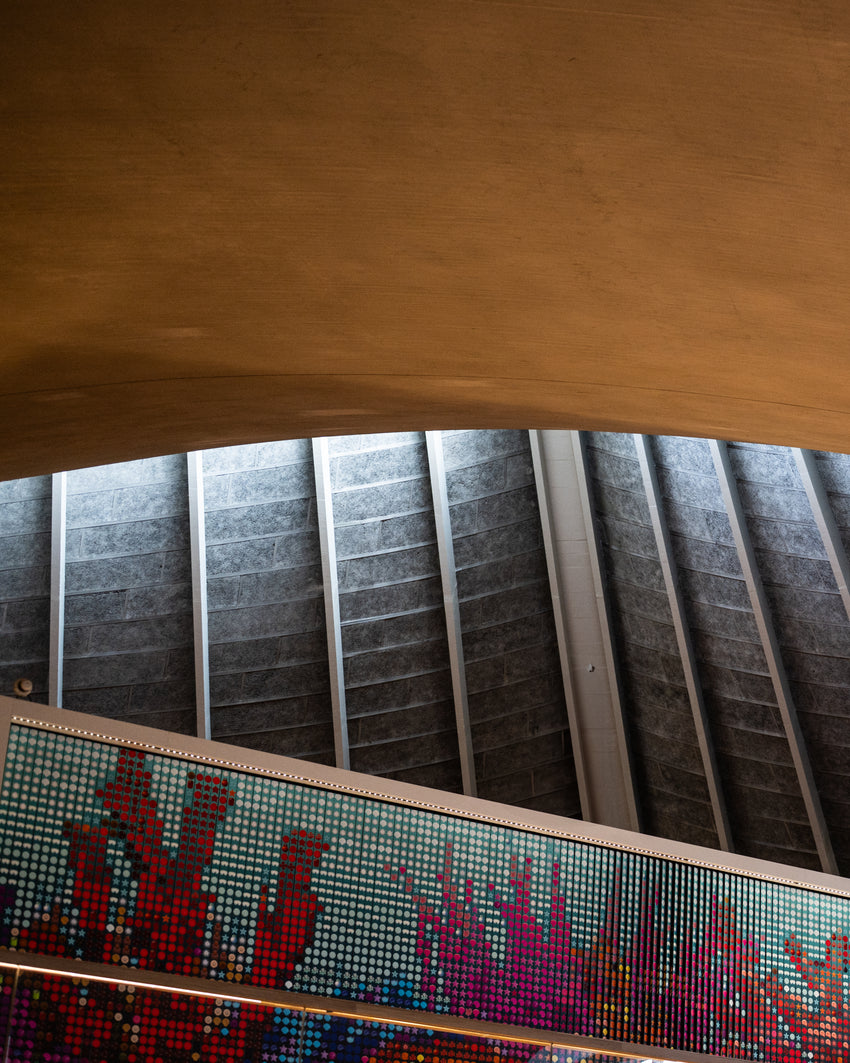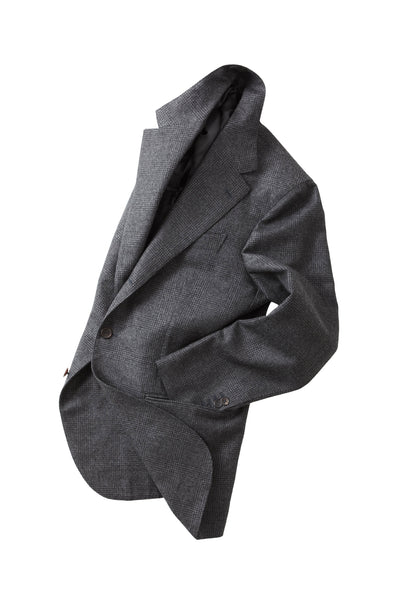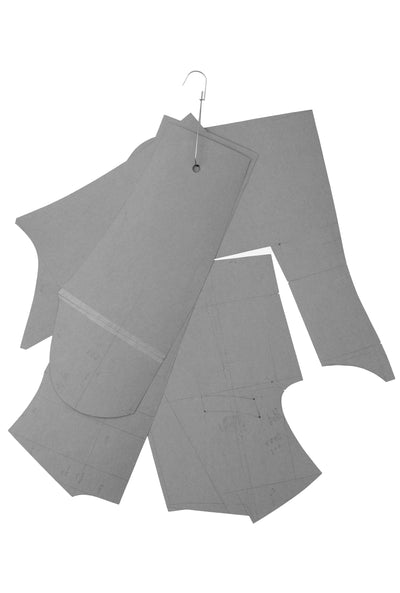Lucia wears a Navy Wool-Cashmere Raglan Sleeve Polo and Bespoke Navy Cavalry Twill Wide-Leg Trousers.

Lucia Savi for Anglo-Italian
May 2025

We paid a visit to Curator and Academic Dr. Lucia Savi at The Design Museum, Kensington. Founded in 1989 by Sir Terence Conran, the museum is a world-leading exhibition and event space devoted to contemporary design in every form.
Last year Lucia delivered a fascinating lecture on her latest work, A New History of "Made in Italy" at 57 Weymouth Street.
The first book to examine the role played by textile manufacturing in the development of fashion in Italy, A New History of 'Made in Italy' investigates Italy's transition from a country of dressmakers, tailors and small-scale couturiers in the early post-Second World War period to a major producer of ready-to-wear fashion in the 1980s.
We're delighted to present these portraits of Lucia in her Wool-Cashmere Polo and Bespoke Wide-Leg Trousers, alongside a recent interview.
With thanks to Lucia & The Design Museum.
-- Anglo-Italian
Photography: Ella Gradwell
You’re fascinated by textiles, who’s an iconic maker we should know about?
Across my research I’ve encountered many little known clusters of incredible textile production which have lacked consumer attention versus famous designers and large brands. One of the most fascinating examples is a moment in 1960s Italy when the textile producer Nattier became synonymous with bold and avant-garde designers. What feels most relevant to today is that Nattier — as a quality, family run textile mill — had many ingredients of the classic Italian success story, but with a twist. Nattier was a carnettista.
The carnettisti were hidden brokers, acting as crucial intermediaries between textile mills and renowned couturiers. Figures like Nattier built their reputations by expertly curating fabric collections, selecting the season's most fashionable textiles based on weave, color, and pattern. They essentially branded these fabrics, marking them with their names on the selvedge, and displayed them in pattern books called 'carnets’. More than mere salesmen, they invested heavily in purchasing full bolts of fabric, guaranteeing sales for producers and shaping the very direction of textile production. Their role extended beyond selection; they interpreted how each textile could be commercialized, often influencing design and production decisions, and ensuring these fabrics reached the ateliers and department stores that defined Italian elegance. They were trendsetters, brand builders, and the essential link in the intricate fashion supply chain, effectively bridging the gap between textile manufacturers and high fashion.
Which individuals had the biggest impact on the postwar growth of ‘MADE IN ITALY' as we know it?
It’s a long list, with some of them becoming almost legendary figures. Giovanni Battista Giorgini was and still is considered by many to be the ‘father of Italian Fashion’, as he spearheaded the first Italian international fashion show in Florence at the Sala Bianca in 1951. Emilio Pucci had a huge impact, as his prints took the American market by storm in the immediate post war period. Very influential, but almost forgotten, are the group of female couturiers who were working in the immediate post war period, such as Simonetta, Princess Galitzine, Vita Noberasco, as well as the duo behind Carosa, Princess Giovanna Caracciolo Ginetti and Barbara Angelini Desalles. Closer to the present day, many designers brought Italian fashion to the international scene, owing in large part to Milan becoming the capital of prêt-à-porter in the late 1970s and 1980s, with stilisti such as Walter Albini, Krizia and of course Versace, Armani and the Missionis.
Beyond the individual creative forces, what is very distinctive of Italian fashion is the notion of family business. In Vogue Italia July–August 1975, an editorial titled “Il Clans degli Italiani” had several full bleed spreads showing the top designers of the day surrounded by his or her entourage: family, friends, business partners and employees. Vogue describes how Italians typically have an individualism that separates them into many small groups, each with its own precise style code. The piece concludes that the Italian fashion industry and prêt-à-porter did not signify a unified national style, but an array of distinctive styles, each based on their favourite stilista, their family and entourage.
Rather than being isolated geniuses, as designers have often been presented in recent decades, they were photographed surrounded by their team, all dressed in the brand’s clothing and accessories. This visualizes the core attributes of Italian prêt-à-porter, a total look created in collaboration. They are clans both in terms of the designer’s closed entourage as well as the consumers that buy into that specific style. When I think about MADE IN ITALY I think not of garments and the centrality of a ‘genius’ designer, but instead of the materials, know-how and production that sits behind the final products. My latest book considers MADE IN ITALY not as a brand but as a process and network, going behind the scenes to explore what the ‘MADE’ part actually involves and what lessons we can draw from it.
The Design Museum, Kensington.
How did Italian textile makers and popularity amongst consumers help create the 'MADE IN ITALY' label?
In the immediate postwar period, textiles were the key element driving sales and attention from buyers, with their significance evident in the display, commerce, and advertisement of Italian fashion during that period. Foreign press and buyers regularly commented upon Italian fibers, fabrics and their means of production, with praise for textile qualities often eclipsing any appreciation of the cut or style.
The interest in and approval of Italian textile production provided a way for Italy to find its own voice and build its post-war fashion economy, as the textile industry was relatively untarnished. Furthermore, fashion, fabrics, and textiles, like other scarce goods with a high “export capacity,” were used in the post-war years as a means of exchange and often also as political tools. The European Recovery Program’s (ERP) aid to Italy’s textile industry was widely claimed to have helped Italy become a center of the fashion world.
Fibers, fabrics and textiles were significant protagonists in both the making and allure of garments in post-war Italy. Consumers and producers were aware of the crucial role that they played in fashion, as highlighted in the pages of magazines such as Vogue, Harper’s Bazaar, Linea, and Novità.
These magazines included diverse and often evocative designations combining the name of fabrics or companies with their characteristics, such as Woollena, Costsurah, Valchiria Satinato, and Drapsusa, whilst fabric producers proudly promoted fashion couturiers who used their fabrics with full-page color advertisements.
The emphasis placed on fabrics rather than finished garments in fashion magazines is symptomatic of the fact that many readers would have known how to sew or knit at the time, and that most Italian consumers were purchasing made-to-measure clothes from dressmakers.
As you well know, the act of commissioning a garment ideally requires some knowledge of the different types of materials available, their cost, and the way in which they drape and feel on the body. The presence of fashion patterns offered in magazines for readers’ private use and the regular long articles describing new fabrics, colors, textures, and properties were aimed at knowledgeable readers and catered to their needs. The January 1957 issue of Harper’s Bazaar UK has a front cover announcement heralding “15 pages of fabric news”, you cannot imagine anything similar today. At this time, fabrics came first and were instrumental in advertising and selling fashion.
The Design Museum, Kensington.
How did you get into fashion?
At university in Milan I was immersing myself in the world of art history. When it came time to study textile production for my MA thesis, I did something a bit unusual and instead of studying Italian production I came to London. From art history and the artist’s perspective I became fascinated by the Bloomsbury group and their design collective Omega Workshops, a short lived operation where the artists started to decorate vibrant interiors, rebelling against the Victorian aesthetic. That research led to a passion for textiles that further blossomed when working on The Glamour of Italian Fashion 1945–2014, an exhibition at the V&A well over a decade ago. During this period, I spent quite a bit of time traveling around Italy visiting little-known state archives, company collections, and textile manufacturing plants. While all the preparation of the exhibition exposed me to the country’s creativity, production skills, and history, these visits were a particularly eye-opening experience. I knew what Italy was producing in terms of textiles, but I did not know how. Visiting a wool manufacturer in Prato and a silk maker in Como became the starting point of my PhD and book A New History Of "Made in Italy".
In parallel with my PhD journey, I continued my curatorial career and after the Italian Fashion exhibition, specialised in researching and curating fashion exhibitions. I worked on the V&A exhibition Shoes: Pleasure and Pain (2015) and then I was lead curator on the V&A exhibition Bags: Inside Out (2020), before working with the curatorial teams on exhibitions at the Design Museum.
The Design Museum, Kensington.
What's your role at the Design Museum currently?
I am currently Head of Curatorial and Interpretation at the Design Museum, where I head a group of incredible curators responsible for creating the exhibition content of our programme.
My first exhibition at the museum was Object of Desire: Surrealism and Design 1924 – today. The exhibition had its origins at the Vitra museum and I had the privilege of investigating the British history of Surrealism; for the show we borrowed iconic objects from the Edward James’ collection, including the drawing of the Dali lip sofa on a envelope, as well as Dali’s portrait of Lucian Freud from the Freud museum.
I have been very involved in our latest exhibition Splash: a Century of Swimming and Style and am currently co-curating our major Autumn retrospective, Wes Anderson: the Archives.





